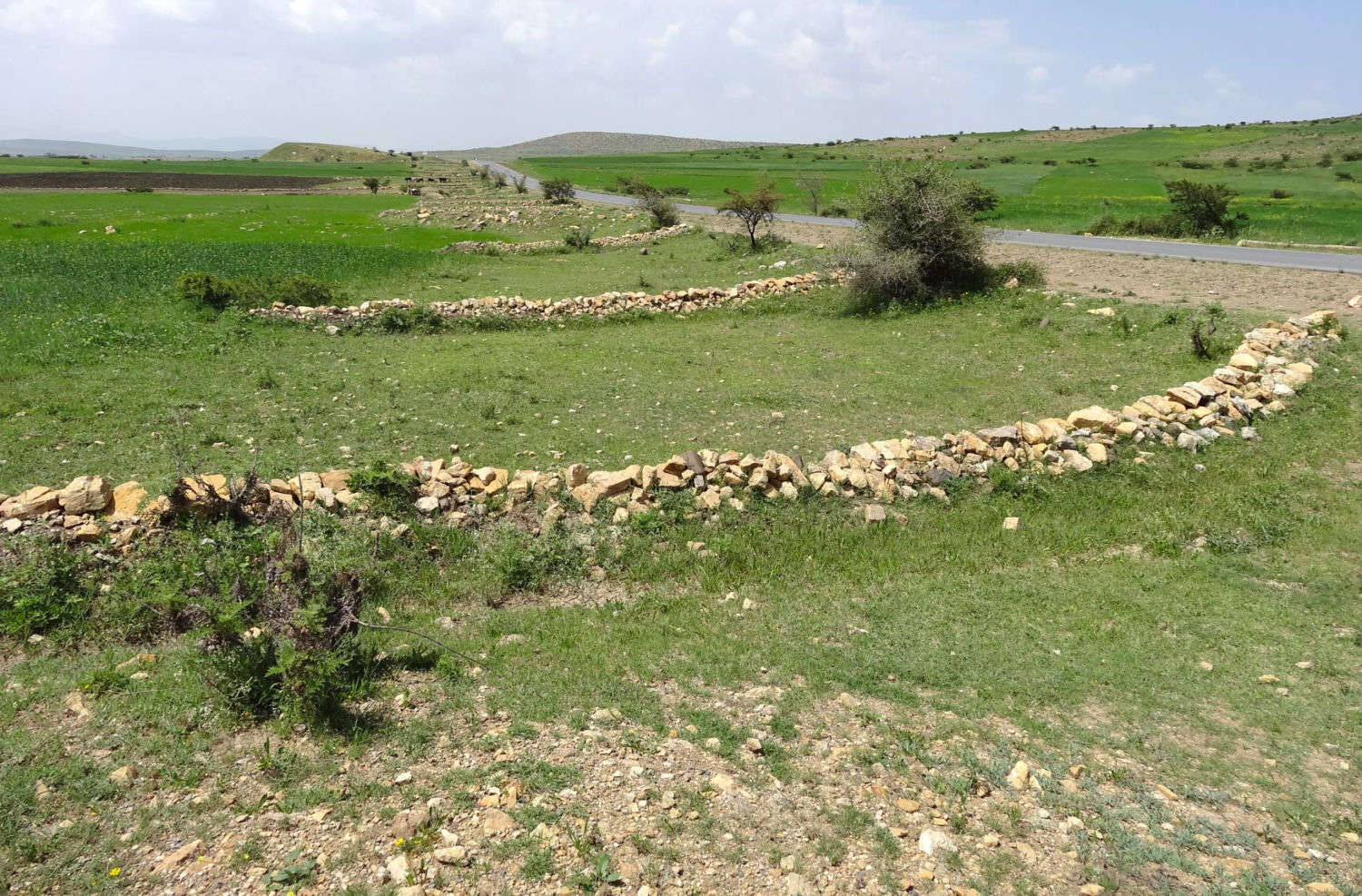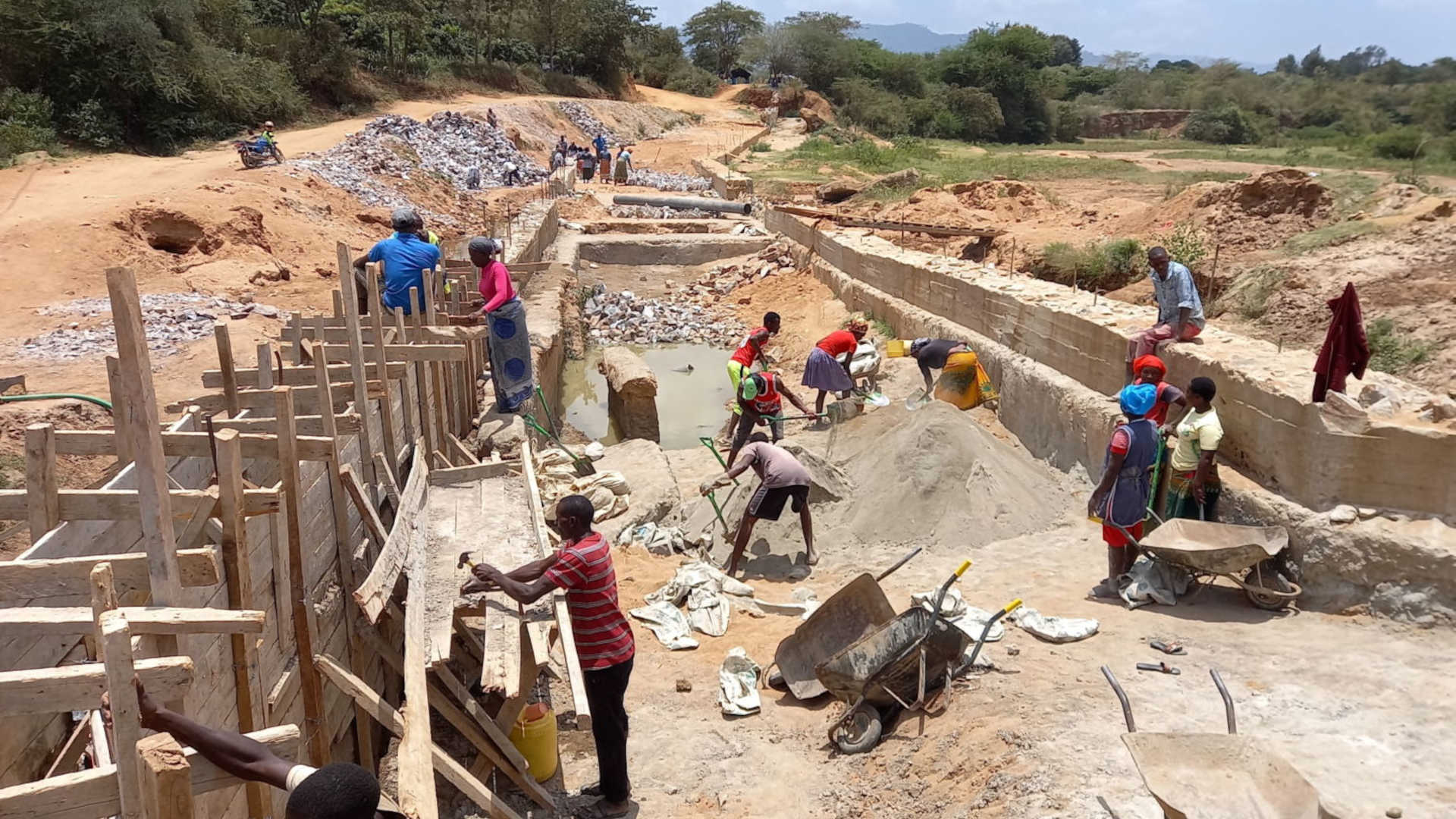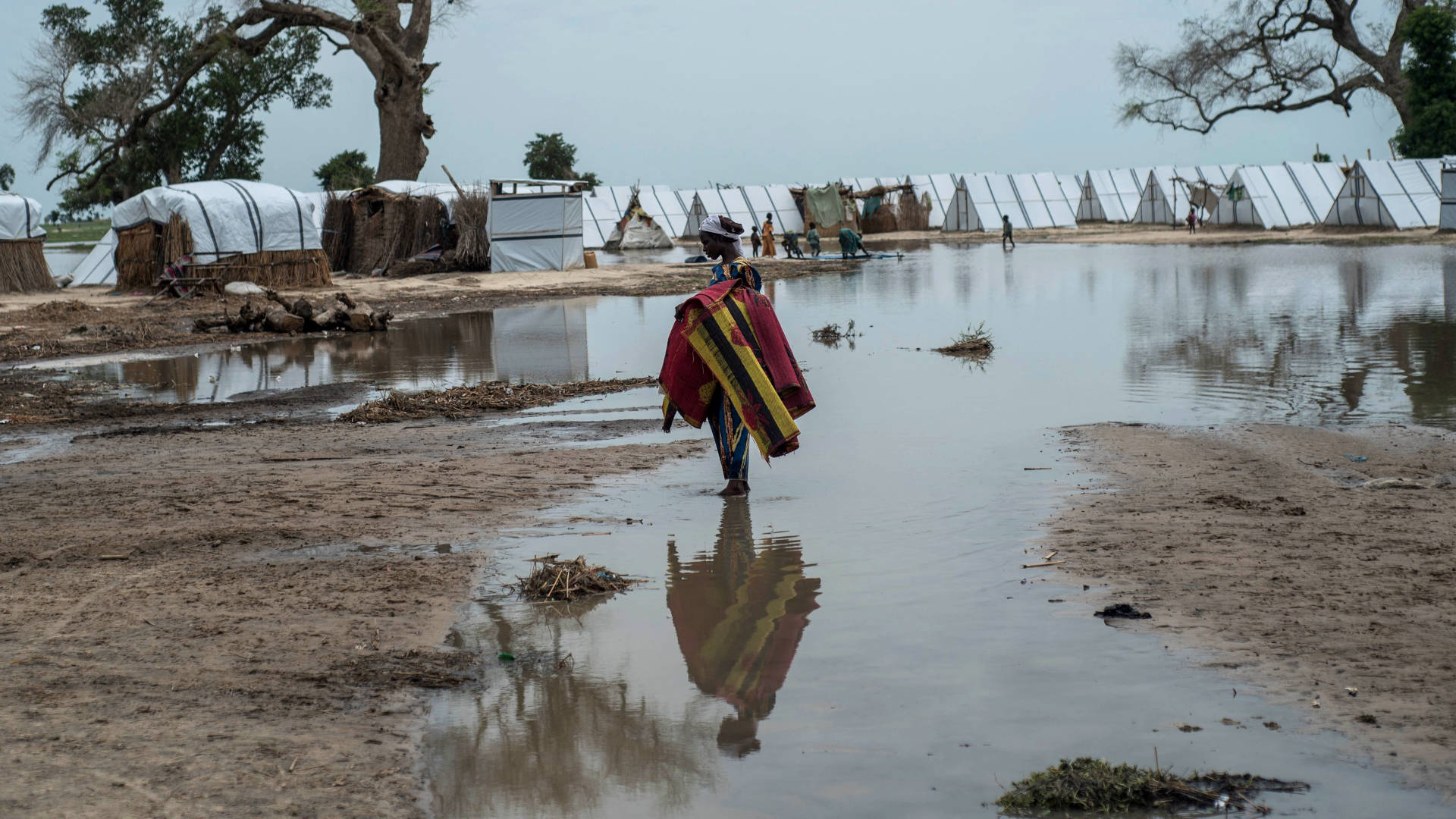In Developing Nations, ‘Green Roads’ Buffer Drought and Floods
Makueni County, a corner of southern Kenya that’s home to nearly a million people, is a land of extremes. Nine months a year, Makueni is a hardened, sun-scorched place where crops struggle and plumes of orange dust billow from dirt roads. Twice yearly, though, the county is battered by weeks of torrential rain, which drown farm fields and transform roads into impassable morasses. “Water,” says Michael Maluki, a Makueni County engineer, “is the enemy of roads.”
Maluki’s axiom is true the world over: Where roads and water intersect, trouble follows. Roads cut off streams and bleed sediment; meanwhile, floods often erode roadbeds into muddy gullies. Although wealthy nations are far from immune, these problems are most severe in developing countries, where roads are largely unpaved and thus especially vulnerable to obliteration. In Kenya and other nations, the issue is exacerbated by climate change, which has amplified the intensity of seasonal monsoons and droughts.
This story was originally published by Yale e360 and is reproduced here as part of the Climate Desk collaboration.
In 2019, Maluki began to ponder how to reconcile two of his county’s challenges: the aridity of its dry season and the destructiveness of its wet season. That year, he and colleagues attended a local workshop led by a Dutch consulting firm called MetaMeta on the concept of “Green Roads for Water” — a set of precepts for designing roads to capture water through strategic channels, culverts, and ponds and divert it for agricultural use. Inspired by the session, Maluki brought the idea to his colleagues and local farmers, who gave Green Roads their cautious blessing.
Makueni County’s Green Roads quickly proved their worth. Along roadsides, Maluki’s team members installed “mitre drains,” which shunted floodwaters into newly dug channels that irrigated mangoes, bananas, and oranges. They excavated farm ponds, which stored the rainy season’s floodwaters for use during drought, and they planted roadside fruit trees to absorb runoff and help control the dust that billowed from unpaved roads. And where travel routes crossed ephemeral rivers at right angles, the county built drifts — concrete road segments that also functioned as makeshift dams. During seasonal floods, the drifts captured deep banks of sand on their upstream sides. The sand retained pockets of water, which farmers tapped during the dry season via four-foot-deep wells dug upstream of the drift. In neighboring Kitui County, one study found that every $400 spent on similar low-tech tweaks increased farmers’ yields by around $1,000; according to Maluki, they’ve also made the rainy season far less damaging.
Where roads and water intersect, trouble follows. Roads cut off streams and bleed sediment; meanwhile, floods often erode roadbeds into muddy gullies.
“The biggest asset for [the county government] in this program is the reduction of maintenance costs,” Maluki says. “It’s a two-way benefit.” He estimates that between 5 and 10 percent of the counties’ roads now apply water-harvesting principles.
Southern Kenya isn’t the only place seeing such gains: Nearly 20 countries have either implemented Green Roads for Water or plan to begin soon, and thousands of kilometers of roads, worldwide, have already received Green Roads interventions. Engineers who have taken MetaMeta’s trainings have employed its tenets in Ethiopia and Bangladesh, and the concept is rapidly spreading to places as diverse as Somaliland, Tajikistan, and Bolivia. The idea has also gained a toehold at the World Bank and other international lending institutions, which are currently financing a road-building boom that promises to reshape ecosystems and communities around the world. Green Roads for Water offers one potential path through this thicket of new construction, one that repositions roads as environmental assets as well as liabilities.
“By integrating these small and easy practices, you can have very big benefits,” says Anastasia Deligianni, manager of MetaMeta’s Green Roads for Water program. “We think this is a critical moment to really do it right.”
Green Roads for Water is the brainchild of Frank Van Steenbergen, a Dutch geographer and MetaMeta’s director. While working on irrigation projects in Pakistan in the early 1990s, van Steenbergen first encountered “gabarbands,” stone terraces likely built by farmers millenia ago to capture water and soil from seasonal rivers during monsoons. The gabarbands were proto-dams, but their sinuous paths across ancient streambeds also reminded van Steenbergen of roads, which tend to gather water along their surfaces. In the years that followed, he began to wonder: Why not use roads to direct and collect water in desirable locations, rather than undesirable ones?
The idea’s first major test occurred in the Ethiopian state of Tigray. Every year, the region’s farmers take part in a weeks-long volunteer restoration effort known as “mass mobilization,” rebuilding terraces and clearing irrigation canals. In 2015, the mobilization included the application of Green Roads principles. Among other measures, Ethiopian farmers dug new trenches and ponds and installed “floodwater spreaders” — low earthen berms that channeled road runoff into adjacent fields of maize, wheat, and barley.
The results, says Kifle Woldearegay, a geoengineer at Ethiopia’s Mekelle University, were dramatic. By 2018, so much water had infiltrated the soil around Tigray’s Green Roads that the water table had risen around two meters, improving the productivity of adjacent farms by 35 percent. Woldearegay has estimated that Tigray’s efforts produced nearly $17,000 in agricultural and infrastructural benefits for every kilometer of road the state treated — around a fourfold yield on the government’s investment.
“Farmers were very happy,” Woldearegay says. “They see that moisture is retained in their farmlands and landscapes, and that their crops are performing better.” Today, he says, practically every road in Tigray has been retrofitted with at least some water-harvesting techniques.
Buoyed by their success in Ethiopia, van Steenbergen and a growing network of collaborators have refined the precepts of Green Roads for Water. The techniques tend to be astonishingly simple. Gentle earthen ridges called crossbars guide water off roads and toward irrigation ditches. “Borrow pits” left after the excavation of gravel can be repurposed as rainwater collection ponds. In Bangladesh, engineers have deployed gated culverts to channel floodwaters into rice paddies. “It is often very non-glorious things that make the difference,” van Steenbergen says.
“People are very creative. These are all things that can be easily replicated.”
Although MetaMeta coined the term “Green Roads for Water,” van Steenbergen is adamant that no single entity owns the concept. MetaMeta holds no patents nor licenses any technologies; it merely conducts trainings and assessments, and it offers technical guidance to road-building agencies. Many of the techniques it promulgates were developed by local engineers and farmers: for example, an Ethiopian drain design that might also apply to Yemen, or a Pakistani culvert with relevance in Tajikistan. “People are very creative,” says van Steenbergen. “These are all things that can be easily replicated.”
As Green Roads practices have cohered, the concept has garnered institutional support. The German NGO Welthungerhilfe has funded Green Roads trainings and construction in Somaliland; the Global Resilience Partnership has funded assessments in Ethiopia, Kenya, and Nepal; and the International Fund for Agricultural Development and the United Nations World Food Program have organized events on the topic. In 2021, the World Bank hired MetaMeta to compile a set of guidelines delineating the principles of Green Roads for Water and highlighting successful case studies. The approach, says Kulwinder Singh Rao, the World Bank’s lead transport specialist, “offers a new way of thinking” about the relationship between roads and water. “Practitioners and policymakers in the road sector need to embrace this new concept.”
The Green Roads movement is expanding in an era of unprecedented road construction in developing nations. William Laurance, an ecologist at James Cook University, has dubbed the phenomenon an “Infrastructure Tsunami” — a wave of construction that could produce more than 15 million miles of paved roads by mid-century and tens of millions of miles of unpaved roads. This exploding transportation network may produce immense benefits for human welfare. “Once there is a road, there is everything,” says Saroj Yakami, an engineer who spearheads the Green Roads movement in Nepal, where thousands of road miles have been constructed since 2015. “You can go to the hospital easily. You can get government services quickly. You can take your produce to the market.”

Yet this enhanced connectivity often comes at a high social and ecological price. In the Amazon, Laurance has found, the vast majority of deforestation occurs near roadways; in Nepal’s Chitwan National Park, researchers have cautioned that roads stand to “cause dramatic reductions in tiger numbers” over the next two decades. According to Yakami, shoddily bulldozed Himalayan roads often leave behind wedges of spoil, which absorb water and trigger devastating landslides. “They’re taking roads everywhere, and that is not good for the environment,” he says.
In some cases, roads provide benefits and costs simultaneously. According to Yakami, new Nepalese roads have cut off mountain springs that have long sustained farms and households, but they’ve also revealed long-buried springs. Left to flow, the unearthed springs turn dirt roads into unstable slicks of mud. But channeled into taps and pipes, they can become important water sources for drought-stressed villages. This approach differs from Green Roads strategies in Ethiopia or Kenya, where roads have primarily been modified to capture rainfall rather than groundwater, but it similarly tries to synchronize road design with water delivery infrastructure.
But if roads can be recast as boons for water provision, will that framing provide a perverse incentive to build more of them? The very notion that a road can be “green” seems oxymoronic: A vast body of scientific literature demonstrates that roads befoul air and water, fragment ecosystems, introduce non-native species, and obliterate wildlife. In an email, Laurance expressed worry that “water harvesting might become a driver of road expansion in arid environments.”
“Once there is a road, there is everything.”
Deligianni doesn’t dismiss those fears outright, but she doesn’t give them much credence. For one thing, most Green Roads for Water techniques have thus far been applied as retrofits to existing roads, rather than included in new ones. For another, she says, new roads are inevitable and, in many cases, desirable to local communities. So why not optimize the construction to come? “We’re looking at the projections for the future, and so many roads are going to be built,” Deligianni says. “We’re just trying to change the narrative and add some benefits.”
For now, the Green Roads movement, for all its institutional momentum, is moving forward in fits and starts. The idea, says the World Bank’s Singh Rao, requires “a paradigm shift in thinking and practice,” one that entails cooperation across agencies that tend to be siloed. In Ethiopia, Woldearegay says that agricultural ministries are enthusiastic about Green Roads and have incorporated them into their own technical guidelines, but road departments themselves have proved reluctant. “They don’t want the costs associated with designing and implementing [them],” he says. That’s the case in Kenya’s Makueni County, where limited budgets have hampered progress.
Yet these projects continue to attract attention: In recent months, Michael Maluki has given Green Roads tours to newspaper reporters, engineers, and farmers from neighboring counties. “We have been receiving so many visitors,” Maluki says. “The small things we do here, people are noticing.”
Ben Goldfarb is a Colorado-based environmental journalist whose writing has appeared in The Atlantic, National Geographic, and Smithsonian Magazine, among other publications. He is the author of “Crossings: How Road Ecology Is Shaping the Future of Our Planet.”











